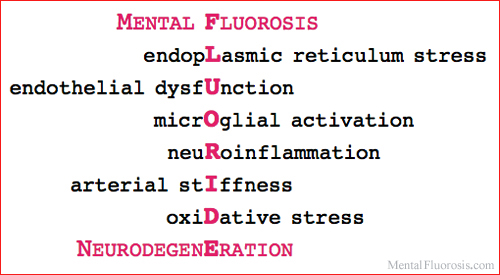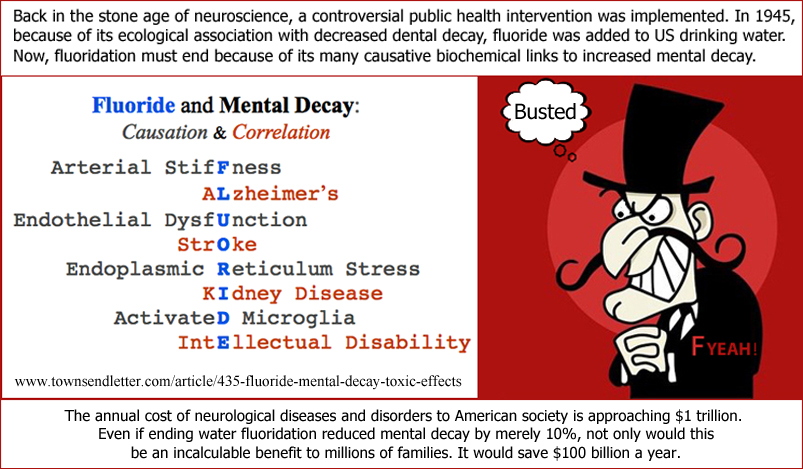
(text in graphic links to its section)
Endoplasmic Reticulum Stress
Fluoride and ER Stress
Dental Fluorosis: Researchers at the Forsyth Institute in Massachusetts, a fluoride research center for the past century, found that fluoride initiates an ER stress response in ameloblasts that interferes with protein synthesis and secretion – culminating in dental fluorosis. Beginning with the lowest dose tested, they observed an increase in the magnitude of ER stress with increasing doses of fluoride. [Sharma R, et al. 2008]
Ameloblasts are cells present during tooth development that secrete large amounts of proteins that later mineralize to form tooth enamel.
Skeletal Fluorosis: Fluoride causes ER stress during osteoblast maturation. [Zhou et al. 2013] Osteoblasts are cells that secrete the protein matrix for bone formation.
• The severity of osteofluorosis is associated with accumulation of fluoride in bone, in a dose-dependent manner. [Liu L, et al. 2015]
Pineal Fluorosis: Because it is not protected by the blood-brain barrier, the pineal gland is exposed to fluoride in the bloodstream. Its fluoride concentrations are positively related to calcium concentrations. By old age, the fluoride/calcium ratio in the human pineal gland is higher than in bone. [National Research Council (1) 2006; Luke 2001] (See MacArthur 2013)
• Animal research has found fluoride concentrations four times higher in the pineal gland than in the skull or the brain. [Kalisinska et al. 2014]
Soft Tissue Fluorosis: Fluoride exposure induced excessive ER stress and associated apoptosis (cell death) in the hippocampus of rats, resulting in histological and ultrastructural abnormalities that impaired learning and memory capabilities. [Niu et al. 2018]
• Fluoride has also been shown to induce ER stress that causes cell death in spleen lymphocytes [Deng et al. 2016] and in immature sperm cells. [Yang Y, et al. 2015]
Placental Fluorosis: Women who drank water fluoridated at 1.0-1.2 ppm (parts per million) averaged 2 ppm fluoride in their placentas – nearly three times higher than in women who drank unfluoridated water. [Gardner et al. 1952] (See MacArthur 2015)
ER Stress and Neurodegeneration
The endoplasmic reticulum is the main compartment involved in protein folding and secretion and is drastically affected in Alzheimer's disease neurons. [Gerakis et al. 2018]
• Accumulating evidence indicates that chronic ER stress is of paramount significance in development and progression of many neurodegenerative diseases whose pathology includes accumulation of misfolded proteins in the brain. [Mahdi et al. 2016]
• In stroke and Lou Gehrig's disease, chronic activation of ER stress is considered as main pathogeny. [Zhang et al. 2015]
• ER stress and accumulation of several types of misfolded proteins (β-amyloid, Tau, alpha-synuclein, etc.) are associated with most of the brain pathology processes observed in the development of Alzheimer's disease. [Li JQ, et al. 2015]
Pineal gland calcification is significantly higher in patients with Alzheimer's disease. [Mahlberg et al. 2008]
ER stress also mediates the pathogenesis of psychiatric diseases, such as depression, schizophrenia, sleep fragmentation, and post-traumatic stress disorder. Inhibiting specific causes of ER stress may help prevent neurodegeneration. [Xiang et al. 2017]
Low lymphocyte levels (lymphopenia) is associated with reduced survival due to heart disease, cancer and respiratory infections, including influenza and pneumonia.
[Zidar et al. 2019]
Note: ER stress is a central mechanism in the pathogenesis of preeclampsia, the life-threatening pregnancy complication caused by the abnormal placenta. [Burton et al. 2011]
